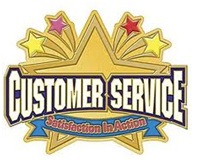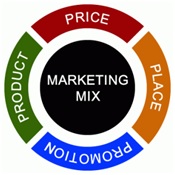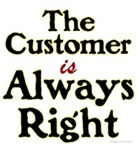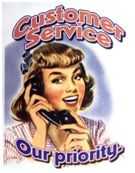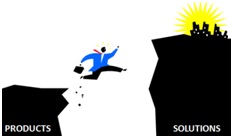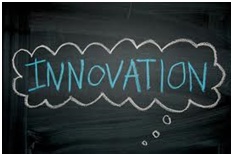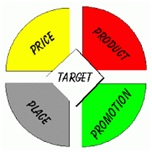|
 |
|
 |
Marketing and customer
satisfaction
Marketing is... Winning and keeping customers by continually satisfying their needs and wants with the marketing mix (the 4 P’s):
1. Price What customers are charged (see pricing).
2. Place Where the product is sold e.g. a store or the Internet (see distribution and logistics).
3. Product The product itself that must give customers benefits:
See product strategy.
4. Promotion Ways to sell the product (see advertising and promotion).
What's the link between marketing and business success? Marketing (or customer satisfaction) is a philosophy for successfully running any organization (called the “marketing concept”) This means that everyone in the organization must be totally dedicated to customer satisfaction.
The 8 Golden Rules of Marketing 1. Put your customers first (but remember you need great employees to deliver great service - see the service-profit chain)
2. Know your customers. (see market research and market segmentation)
3. Make what you can sell (not sell what you can make).
4. No customers mean no business 5. The customer is always right (even if they're wrong!)
6. Deliver what customers want now and in the future (better and faster than competitors).
7. Loyal customers are very profitable (research in America has shown that it costs at least five times more to win a new customer than keep a loyal one).
8. Exceed customers’ expectations Delight customers by delivering more than they expect.
How to delight customers (SERVICE): Solutions (providing unique solutions to customers)
Employees (happy employees mean happy customers)
Remember the 4 P’s (price, place, product and promotion).
Visionary leadership (inspirational customer driven leaders). Intimacy (building long-term relationships with customers).
Creativity (finding creative solutions to customers’ problems).
Empathy (seeing the world from the customers’ point of view).
Here are these seven points in more detail: 1. Solutions An organization must provide unique solutions to customers’ problems i.e. a unique selling proposition (USP). This involves:
How can an organization differentiate its product?
a) make sure your 7 S’s are driven by your customers’ wants
b) innovation Improvements in technology, design, quality, image and packaging.
c) IT Using computers to give as much information to employees as quickly as possible, so that they can make customer friendly decisions. d) look after the little things Small improvements in service can have a big impact on customers.
e) speed Be as fast as possible from receipt of order to delivery to the customer, eliminating unnecessary bureaucracy (e.g. meetings and reports).
f) long-term relationships with suppliers and distributors (ensuring they give maximum value to customers). g) right price Being aware of how sensitive customers are to changes in price.
h) brand loyalty Using a brand’s good reputation to create customer loyalty.
2. Employees
Happy employees mean happy customers and higher profits (as explained by the service-profit chain). So employees must be: a) motivated (extra effort) – through – interesting work. – pride in the organization (so business ethics and social responsibilities are important) – rewards for customer satisfaction.
b) empowered Having the skills, self-motivation and information to take responsibility for solving customers’ problems either:
A survey by Britain’s Institute of Customer Service in 2005 showed that helpful, friendly staff (and product quality) were vital to customer satisfaction. 3. Remember the 4 P’s Price, place, product and promotion should be right for the customers you’re aiming at (your target market) - see above.
4. Visionary leadership The organization’s chief executive must
(like the founder of Wal-Mart stores in America, Sam Walton, pictured right). So the chief executive and every manager should:
5. Intimacy The best organizations create long-term, intimate (or close) relationships with their customers (called relationship marketing, or customer relationship management, CRM). Value your customers because of
6. Creativity Continual innovation is vital – customers must be constantly given more creative (and better) solutions to their problems.
7. Empathy See the world from the customers’ point of view. Use market research to find out who (and where) they are, and why they buy things (see market research , market segmentation and buyer behaviour). But what customers want (e.g. Coke) may not be what they need (e.g. water), and they may be persuaded to buy things that are bad for them like cigarettes and fast food. So it is society's responsibility to educate people to make the right choices.
Key quotes explained
“The organization must learn to think of itself not as producing goods or services but as buying customers, as doing the things that will make people want to do business with it” - Theodore Levitt , American marketing professor (pictured right) So another American management writer, Peter Drucker, said “The aim of marketing is to make selling superfluous”. The best way to do this is to sell customer solutions, says Levitt, because “People don’t buy things but buy solutions to problems”.
“You’re selling trust” - Philip Kotler, American marketing professor (pictured right) Business success depends on creating the best possible long-term relationships with customers, because of repeat purchases and word of mouth advertising. Theodore Levitt said that company-customer relationships should be like a marriage!
“Marketing is the art of creating and satisfying customers at a profit” - Philip Kotler (American marketing professor). This emphasizes the importance in marketing of the 3 C’s: customers, creativity and cash (making money). But customers are the most important, because without them the organization would not exist. So the American economist, Paul Samuelson (pictured right) , said “The consumer...is the king”. The founder of Wal-Mart stores in America, Sam Walton, also commented “There is only one boss: the customer”.
Best books
Peter Drucker (pictured right), The Practice of Management (1954) The purpose of a business should be “to create a customer”. So it has only two functions: marketing and innovation. Marketing (or customer satisfaction) isn’t just the responsibility of the marketing department but every employee must believe in and live by it. So marketing is “the whole business seen from the customer’s point of view”. (For more detail see The Practice of Management in the Business Books section).
Theodore Levitt, The Marketing Imagination (1983) The best corporate strategy aims to create and satisfy customers through:
(For more detail see The Marketing Imagination in the Business Books section).
Gary Hamel (pictured right) and C.K. Prahalad (pictured right below), Competing for the Future (1994) An organization must satisfy unarticulated needs (they can’t express) as well as articulated
ones. It must create new markets and develop revolutionary new products (what Hamel and Prahalad call “expeditionary marketing”). (For more detail see Competing for the Future in the Business Books section).
Michael LeBoeuf (pictured right) , How To Win Customers and Keep Them For Life (1989) See customers' point of view and consistently provide them with:
“A satisfied customer is the best business strategy of them all”, says LeBeouf. Other tips on customer satisfaction are:
Customer loyalty is vital because...
Regis McKenna (pictured right) , Relationship Marketing (1991) “Marketing is everything and everything is marketing” i.e. customers must rule every organizational activity, because vital to business success are:
|
|
|
||
|
|
|
||
|
||
| Copyright © wisdomtowin.com All Rights Reserved | ||
|

